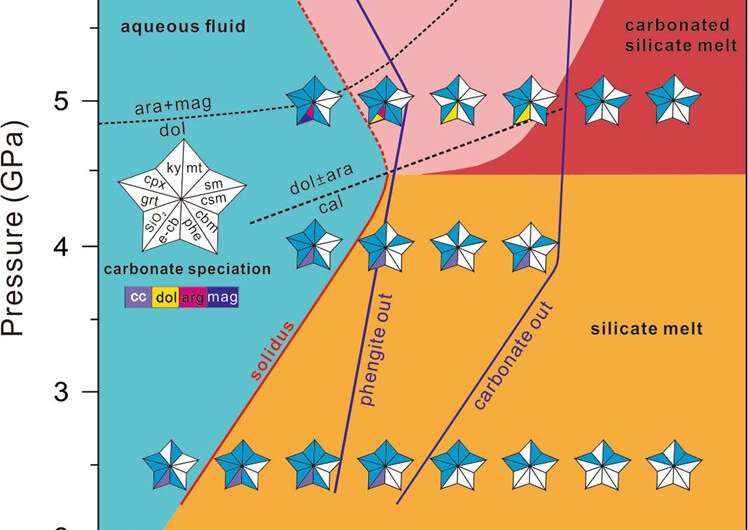Carbonatitic liquid acts as medium for transferring carbon from slab to subarc mantle
Deep carbon cycling at subduction zones affects the long-term habitability of Earth’s surface by regulating atmospheric CO2 concentrations. How the carbon is transferred from the slab to the subarc mantle has thus far eluded researchers.
Recently, a research team led by Prof. Zhang Guoliang from the Institute of Oceanology of the Chinese Academy of Sciences (IOCAS) has found that hydrous carbonatitic liquids act as a pervasive agent to transfer carbon from the slab to the subarc mantle.
The study was published in Communications Earth & Environment on March 15.
The researchers determined the phase relation of subducting carbonated pelites using high-pressure, high-temperature experiments. The results showed that partial melting yielded hydrous silicate melts at 2.5–4 GPa, whereas the liquids close to the solidus over 5–6 GPa were hydrous, calcic carbonatitic liquids, which were replaced by carbonated silicate melts at higher temperatures.
In addition, the minimum temperatures required for the studied pelites to produce silicate melts increased with increasing pressure from 2.5 to ~4.5 GPa, however, they decreased by approximately 50℃–60℃ between 4.5 and 6 GPa as the initial liquids became essentially carbonatitic.
In the framework of the fluid-present solidus for carbonated pelites constrained by this study, previously constructed slab thermal structure and the stability field of serpentinized hydrous minerals, flux melting of carbonated pelites and formation of hydrous carbonatitic liquids were realized in the intermediate thermal regimes at depths of ~150–180 km.
“Carbonatitic liquid, as a medium for transferring carbon from the slab to the mantle at subarc depths, is not restricted to the hottest conditions or to be the hydrous melting of calcium-rich lithologies as previously thought,” said Dr. Chen Wei, first author of the study.
“This study provides a new insight into the mechanism for decarbonation of subducting slab, and sheds light on carbon cycle between Earth’s surface and deep interior,” said Prof. Zhang.
More information:
Wei Chen et al, Pervasive hydrous carbonatitic liquids mediate transfer of carbon from the slab to the subarc mantle, Communications Earth & Environment (2023). DOI: 10.1038/s43247-023-00741-5
Citation:
Carbonatitic liquid acts as medium for transferring carbon from slab to subarc mantle (2023, March 24)
retrieved 24 March 2023
from https://phys.org/news/2023-03-carbonatitic-liquid-medium-carbon-slab.html
This document is subject to copyright. Apart from any fair dealing for the purpose of private study or research, no
part may be reproduced without the written permission. The content is provided for information purposes only.

Deep carbon cycling at subduction zones affects the long-term habitability of Earth’s surface by regulating atmospheric CO2 concentrations. How the carbon is transferred from the slab to the subarc mantle has thus far eluded researchers.
Recently, a research team led by Prof. Zhang Guoliang from the Institute of Oceanology of the Chinese Academy of Sciences (IOCAS) has found that hydrous carbonatitic liquids act as a pervasive agent to transfer carbon from the slab to the subarc mantle.
The study was published in Communications Earth & Environment on March 15.
The researchers determined the phase relation of subducting carbonated pelites using high-pressure, high-temperature experiments. The results showed that partial melting yielded hydrous silicate melts at 2.5–4 GPa, whereas the liquids close to the solidus over 5–6 GPa were hydrous, calcic carbonatitic liquids, which were replaced by carbonated silicate melts at higher temperatures.
In addition, the minimum temperatures required for the studied pelites to produce silicate melts increased with increasing pressure from 2.5 to ~4.5 GPa, however, they decreased by approximately 50℃–60℃ between 4.5 and 6 GPa as the initial liquids became essentially carbonatitic.
In the framework of the fluid-present solidus for carbonated pelites constrained by this study, previously constructed slab thermal structure and the stability field of serpentinized hydrous minerals, flux melting of carbonated pelites and formation of hydrous carbonatitic liquids were realized in the intermediate thermal regimes at depths of ~150–180 km.
“Carbonatitic liquid, as a medium for transferring carbon from the slab to the mantle at subarc depths, is not restricted to the hottest conditions or to be the hydrous melting of calcium-rich lithologies as previously thought,” said Dr. Chen Wei, first author of the study.
“This study provides a new insight into the mechanism for decarbonation of subducting slab, and sheds light on carbon cycle between Earth’s surface and deep interior,” said Prof. Zhang.
More information:
Wei Chen et al, Pervasive hydrous carbonatitic liquids mediate transfer of carbon from the slab to the subarc mantle, Communications Earth & Environment (2023). DOI: 10.1038/s43247-023-00741-5
Citation:
Carbonatitic liquid acts as medium for transferring carbon from slab to subarc mantle (2023, March 24)
retrieved 24 March 2023
from https://phys.org/news/2023-03-carbonatitic-liquid-medium-carbon-slab.html
This document is subject to copyright. Apart from any fair dealing for the purpose of private study or research, no
part may be reproduced without the written permission. The content is provided for information purposes only.
